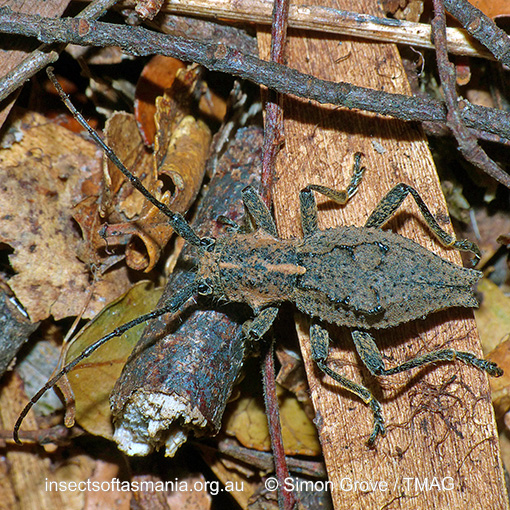
Dorcadida bilocularis (a species of longhorn-beetle)
Basis for Tasmanian occurrence
TMAG collections
Classification
Suborder: Polyphaga
Superfamily: Chrysomeloidea
Family: Cerambycidae
Subfamily: Lamiinae
Tribe: Parmenini
Morphology
Flightedness: functionally flightless
Source literature on morphology and taxonomy (*primary taxonomic source, where identified):
McKeown, K.C. (1947). Catalogue of the Cerambycidae (Coleoptera) of Australia. Mem. Aust. Mus. 10: 1-190.
Ecology
Association with dead wood or old trees: obligately saproxylic
Ecological attributes: — Cassinia aculeata is a host-plant (Bashford, 1990a) — Eucalyptus cordata is a host-plant (Bashford, 1990a) — Nothofagus cunninghamii is a host-plant (Bashford, 1990a) — Richea pandanifolia is a host-plant (Bashford, 1990a) — May occupy logs or trunks of Eucalyptus obliqua, at least temporarily, since found having emerged within a year of felling (Grove & Bashford, 2003) — May occupy logs or trunks of Eucalyptus obliqua, at least temporarily, since found having emerged within six years of felling (Grove et al., 2009).
Collection method(s) for TMAG material: — Emergence trapping from log of Eucalyptus obliqua — Hand collection (substrate not specified) — Knockdown fogging of canopy of Nothofagus cunninghamii — Malaise trapping — Not specified — Pitfall trapping — Rearing in insectary (host not documented).
Source ecological literature:
Grove, S.J. & Bashford, R. (2003). Beetle assemblages from the Warra log decay project: insights from the first year of sampling. Tasforests 14: 117-129.
Grove, S.J. (2009b). Beetles and fuelwood harvesting: a retrospective study from Tasmania’s southern forests. Tasforests 18: 77-99.
Bashford, R. (1990a). Tasmanian forest insects and their host plants: records from the Tasmanian Forestry Commission insect collection. Hobart: Tas. Forestry Commission, 32 pages.
Grove, S. et al. (2009). A long-term experimental study of saproxylic beetle … succession in Tasmanian Eucalyptus … logs… In: Fattorini, S. (Ed.), Insect Ecology and Conservation. Research Signpost, pp. 71-114.
Grove, S.J. & Yaxley, B. (2005). Wildlife habitat strips and native forest ground-active beetle assemblages in plantation nodes in northeast Tasmania. Aust. J. Entom. 44 (4): 331-343.
Harrison, K.S. (2007). Saproxylic beetles associated with habitat features in Eucalyptus obliqua trees in the southern forests of Tasmania. PhD thesis, Dept. of Zoology, Univ. of Tasmania, Hobart.
Taylor, R.J. (1990). Occurrence of log-dwelling invertebrates in regeneration and oldgrowth wet sclerophyll forest in southern Tasmania. Pap. Proc. Roy. Soc. Tas. 124: 27-34.
Yee, M. (2005). The ecology and habitat requirements of saproxylic beetles native to Tasmanian wet eucalypt forests: potential impacts of commercial forestry practices. PhD thesis, Univ. of Tasmania, Hobart.



